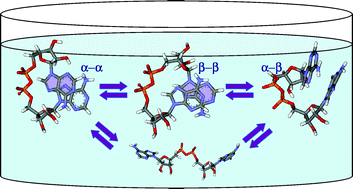What is the conformation of physiologically-active dinucleoside polyphosphates in solution? Conformational analysis of free dinucleoside polyphosphates by NMR and molecular dynamics simulations†
Abstract
Dinucleoside polyphosphates, or dinucleotides (NpnN′; N, N′ = A, U, G, C; n = 2–7), are naturally occurring ubiquitous physiologically active compounds. Despite the interest in dinucleotides, and the relevance of their conformation to their biological function, the conformation of dinucleotides has been insufficiently studied. Therefore, here we performed conformational analysis of a series of NpnN′ Na+ salts (N = A, G, U, C; N′ = A, G, U, C; n = 2–5) by various NMR techniques. All studied dinucleotides, except for Up4/5U, formed intramolecular base stacking interactions in aqueous solutions as indicated by NMR. The conformation around the glycosidic angle in NpnN′s was found to be anti/high anti and the preferred conformation around the C4′–C5′, C5′–O5′ bonds was found to be gauche–gauche (gg). The ribose moiety in NpnN′s showed a small preference for the S conformation, but when attached to cytosine the ribose ring preferred the N conformation. However, no predominant conformation was observed for the ribose moiety in any of the dinucleotides. Molecular dynamics simulations of Ap2A and Ap4A Na+ salts supported the experimental results. In addition, three modes of base-stacking were found for Ap2/4A: α–α, β–β and α–β, which exist in equilibrium, while none is dominant. We conclude that natural, free NpnN′s (n = 2–5) at physiological pH exist mostly in a folded (stacked), rather than extended conformation, in several interconverting stacking modes. Intramolecular base stacking of NpnN′s does not alter the conformation of each of the nucleotide moieties, which remains the same as that of the mononucleotides in solution.


 Please wait while we load your content...
Please wait while we load your content...